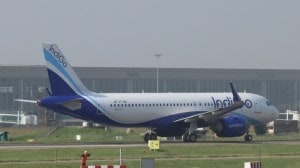
Scores of flights around the world experience varying degrees of turbulence on a daily basis.
It could happen close to the ground, with strong winds acting on aircraft that are taking off or landing; or at higher altitudes, where an “updraft” or downward flow of air can affect aircraft flying through or close to storm clouds.
Turbulence also occurs on the edges of jet streams, the strong, fast, and narrow air currents that circle the Earth.
It is rare for turbulence to result in serious injuries, though. Fatalities, barring exceptions such as the recent incident, are rarer.
That said, studies have shown that the incidence of severe turbulence, especially of the difficult-to-predict clear air turbulence (CAT), has increased with the explosive growth in air traffic, and due to the impact of global warming and climate change.
Story continues below this ad
While modern aircraft are well equipped to deal with turbulence, and both weather forecast and monitoring technology and pilot and cabin crew training are improving constantly, extra caution on the part of passengers, airlines, and aviation regulators will help.
Types & causes of turbulence
Turbulence is irregular motion experienced by aircraft, which is caused by circular whirls (eddies) and vertical currents (updrafts and downdrafts) of air. It could result in minor bumps, or to aircraft being tossed around with large and rapid changes in altitude, potentially leading to injuries to those on board and, in rare cases, structural damage to the plane.
The United States National Weather Service (NWS) says turbulence could be light, moderate, severe, or extreme.
Light turbulence could lead to slight erratic changes in orientation with respect to the horizon — that is, the altitude and attitude of the aircraft. During moderate turbulence, aircraft may experience more notable changes in altitude and attitude, but the plane remains well under control.
Story continues below this ad
In severe turbulence, there are significant and sudden changes of altitude and attitude, and the aircraft could momentarily go out of control. In extreme turbulence, the plane is “violently tossed about” and is “practically impossible to control”.
The causes of turbulence, according to NWS, could be mechanical, thermal or convective, frontal, or wind-shear.
MECHANICAL turbulence is the result of friction between the air and the ground — irregular terrain and man-made obstacles — that leads to formation of eddies. This kind of turbulence is usually found at lower altitudes, but could impact aircraft at relatively higher altitudes while flying above mountain ranges. Mechanical turbulence caused by eddies formed over mountains is called ‘mountain waves’.
CONVECTIVE or thermal turbulence is caused when hot air from certain ground surfaces rises rapidly while cooler air descends, resulting in convective air currents. These currents tend to affect the rate of descent, and can cause difficulties during approach.
Story continues below this ad
FRONTAL turbulence is caused by the lifting of warm air by the sloping frontal surface and friction between two opposing masses of air. This type of turbulence is most palpable when warm air is moist, and is the most common close to thunderstorms.
Turbulence caused by thunderstorms could extend up to 20 miles, according to the NWS. Pilots try to avoid thunderstorms, but fast-changing thunderstorm activity and a large affected area range at times gives them no opportunity to steer away.
WIND SHEAR, according to NWS, is the “change in wind direction and/ or wind speed over a specific horizontal or vertical distance”. Wind shear exists in temperature inversion areas, troughs and lows, and around jet streams. Clear air turbulence, which can be sudden and severe and is extremely difficult to forecast or see, may be considered as a type of wind shear turbulence.
Clear air turbulence
CAT occurs outside of clouds, and usually at altitudes of 15,000 feet or higher. While the reason for the turbulence that caused the Singapore Airlines incident remains unclear, analysts have pointed to a few severe thunderstorms in the region, and the possibility of CAT.
Story continues below this ad
CAT is an invisible threat. While most other types of turbulence can be predicted using data from Earth sensors, satellites, radar, and even visual cues, CAT can come like a bolt out of the cloudless blue. It is virtually impossible for pilots and airlines to plan for this kind of turbulence.
Accounts of some passengers on board the Singapore Airlines flight suggest the aircraft suddenly hit severe turbulence, and many got no opportunity to fasten their seat belts. A meal service was on at the time, and many passengers were not strapped in.
A sudden and violent fall in vertical rate would have exerted negative G force — essentially an upward push — on people and objects inside the plane. Anyone or anything not secured or strapped in would have been thrown upwards. Many passengers slammed into the overhead bins and suffered head and neck injuries. Then, as the aircraft likely gained altitude rapidly, the G force would have brought them crashing down on the floor or seats.
Impact of climate change
Studies suggest climate change could make turbulence more frequent and severe.
Story continues below this ad
A study published last year by researchers from the University of Reading and the UK Meteorological Office found a large increase in CAT between 1979 and 2020 in the mid- and aircraft cruising altitudes. Over the North Atlantic, severe/ greater CAT durations increased by more than 55% over this period.
The study said this was almost certainly the result of climate change, which is strengthening the jet streams that cause turbulence. The researchers also estimated that the frequency of severe turbulence would increase more than that of light or moderate turbulence.
“Our study represents the best evidence yet that CAT has increased over the past four decades, consistent with the expected effects of climate change,” the researchers said. (‘Evidence for Large Increases in Clear-Air Turbulence Over the Past Four Decades’, Prosser et al: Geophysical Research Letters)
Another study, also published last year, submitted that not only CAT, mountain wave turbulence and near-cloud turbulence too will intensify due to climate change going forward.
Story continues below this ad
“…Turbulence generated from all three sources is intensified with higher occurrences globally in changed climate compared to the historical period… Intensification of mountain-wave turbulence and near-cloud turbulence can also be expected with changing climate,” the study said. (‘Global Response of Upper-level Aviation Turbulence from Various Sources to Climate Change’, Soo-Hyun Kim et al: npj Climate and Atmospheric Science)
Staying safe in the air
Even when severe turbulence is the primary trigger, an incident could have multiple contributory factors, including poor training of crew and inadequate dissemination of weather- or wind-related information.
The US Federal Aviation Administration (FAA) recommends that carriers should improve dispatch procedures by keeping communication channels open all the time; include turbulence in weather briefings; promote real time information-sharing between pilot and dispatcher; reinforce the carrier’s turbulence avoidance policy through dispatcher training; consider rerouting using automation, atmospheric modelling, and data displays; and use all applicable weather data as well as reporting and forecasting graphics.
The FAA, which is the world’s leading aviation regulator, also suggests using operating procedures and training to prevent turbulence injuries, emphasising the importance of flight attendants’ personal safety, promoting communication and coordination, and gathering data and reviewing the carrier’s history of turbulence encounters and injuries.
Story continues below this ad
Following the May 21 incident, Singapore Airlines has reviewed and changed some of the cabin crew’s operating procedures. It has said that meal services will be suspended whenever aircraft are flying through turbulence, and that cabin crew will be seated with seat belts fastened during these periods.
Passengers should keep the seat belt fastened at all times unless unavoidable, like when using the lavatory.
Most serious injuries are caused after passengers are dislodged from their seats by turbulence, and the only way to prevent it is to be strapped in even after the seat belt sign has been switched off.









































